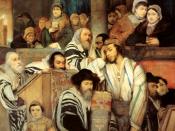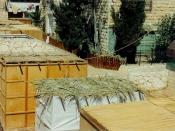Succot
The Jewish Holiday
After the Exodus from slavery in Egypt, the wandering Jews lived in tents or booths,
called Succots. They were pitched wherever they happened to stop for the night. Today it
is called the Succot the festival of booths remembering both the ancient agricultural
booths and those of the Exodus. The harvest festival of thanksgiving, Succot, begins five
days after Yom Kippur, and lasts for eight days. The first two days are the most holy,
during which most Jews do not work. The families construct the booths and decorate it
with branches, and leaves, fruits, and other designs. The roof is covered lightly, so the
stars and the sky can still be seen. Most Jewish families eat all their meals in the Succot,
while some even sleep in them.
During the Succot festival, thanks are given for all growing plants by using four plants
which are symbolic of all the rest.
These four plants also represent the Jewish people. The
Etrog, or the citrus fruit, stands for the people who are educated in the Torah and who do
good deeds. The Lulav, or branch of the date palm, stands for the Jewish people who have
knowledge but no good deeds. The Hadas,or myrtle, symbolizes the people who do good
deeds, but are not educated. The Aravah, or willow, stands for the people who have no
good deeds and no education. These plants are carried around the synagogue in a
procession while prayers are recited for blessings on the land and fruit of Israel. In biblical
times, the willow, the palm, and the Etrog were used in decorating the Succot.
At the end of the Autum harvest, on the fifteenth day of Tishri (September-October)
Succot is celebrated. It is believed that the festival originated...


